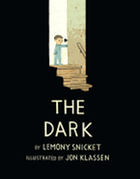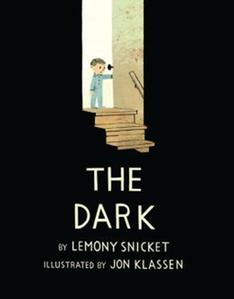

Before readers get to the title page, they see a boy with a flashlight on the far right of a jet-black spread. With a turn of the page, the flashlight reveals, like a spotlight, the title and its creators. "Laszlo was afraid of the dark," the book begins. The boy appears in a triangle of light, seemingly left over from the flashlight's path on the previous page. Already we see the interplay between light and dark in Laszlo's world. The hero looks nervously at the window, where the sun is setting in the rosy rectangle of a window frame; his flashlight is within reach.
The boy and the dark are the sole characters in the book. Post-sunset, the light plays off the staircase in rectangular blocks as the darkness increases its dominance. Snicket's sparest statements cause the scariest effects: "Sometimes the dark hid in the closet. Sometimes it sat behind the shower curtain." A hint of the banister and the first steps appear in the blackness behind the dreaded basement door. Each morning, Laszlo stands in the doorway to the basement and says, "Hi, dark." Sunshine illuminates the top three stairs before blackness consumes the rest. "Laszlo thought that if he visited the dark in the dark's room, maybe the dark wouldn't come visit him in his room."
But that changes when his nightlight burns out. The dark calls his name. It's the first time the dark speaks, in a voice "as creaky as the roof of the house, and as smooth and cold as the windows." As the dark leads Laszlo through the house, we see only what the boy's flashlight reveals--a toy car on the floor, the shower curtain, and finally, the stairs to the basement. Klassen choreographs the scenes with precision, to haunting effect.
The book's only flaw is an overlong explanation from Snicket about why creaky roofs and smooth, cold windows serve a purpose. Up to that point, the narrative has been from Laszlo's perspective. But that does not detract from Laszlo's well-earned victory, synchronized exquisitely between text and artwork. When, in the cold light of dawn, Laszlo ventures as far down as the second landing on the basement stairs, we know he will be just fine. --Jennifer M. Brown
Shelf Talker: Lemony Snicket and Caldecott Medalist Jon Klassen team up for a triumphant picture book about a boy who conquers his fear of the dark.

